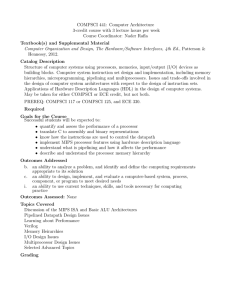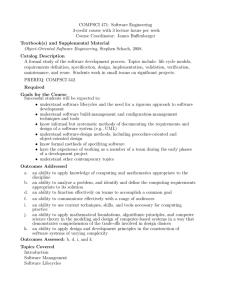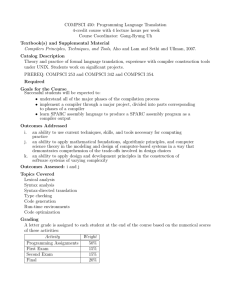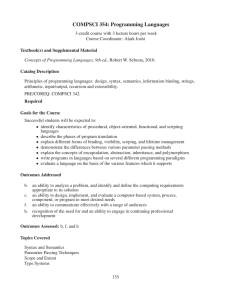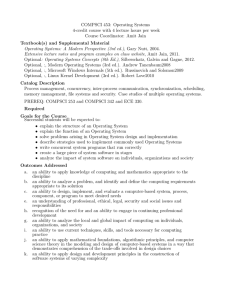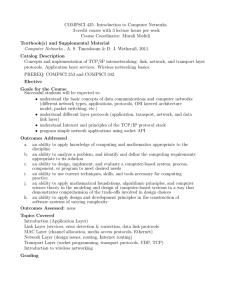Analysis: Algorithms and Data Structures
advertisement
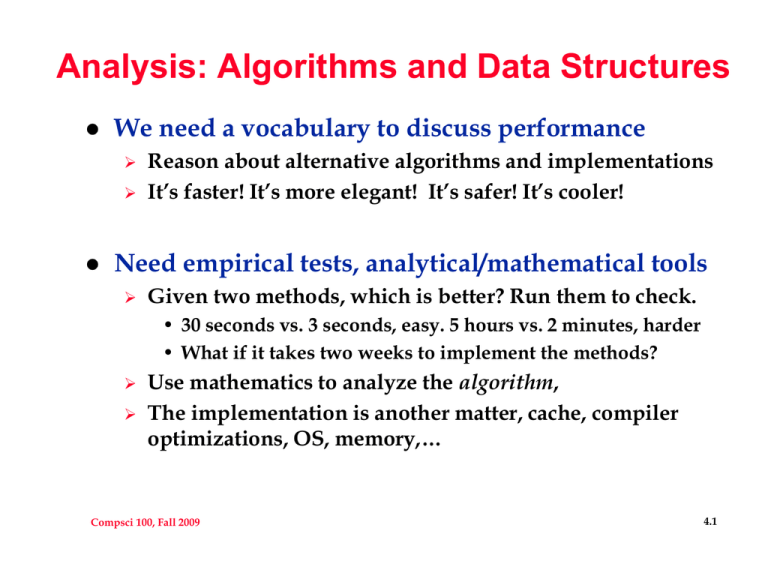
Analysis: Algorithms and Data Structures
We need a vocabulary to discuss performance
Reason about alternative algorithms and implementations
It’s faster! It’s more elegant! It’s safer! It’s cooler!
Need empirical tests, analytical/mathematical tools
Given two methods, which is better? Run them to check.
• 30 seconds vs. 3 seconds, easy. 5 hours vs. 2 minutes, harder
• What if it takes two weeks to implement the methods?
Use mathematics to analyze the algorithm,
The implementation is another matter, cache, compiler
optimizations, OS, memory,…
Compsci 100, Fall 2009
4.1
How fast does the code run?
“As soon as an Analytical Engine exists, it will
necessarily guide the future course of the science.
Whenever any result is sought by its aid, the
question will then arise — by what course of
calculation can these results be arrived at by the
machine in the shortest time?”
Babbage, Analytical Engine 1864
Question: What’s the fastest way to sort a million
32-bit integers?
Obama’s answer: I don’t think the bubble sort is the
way to go
Compsci 100, Fall 2009
4.2
What is a list in Java?
Collection of elements, operations?
Add, remove, traverse, …
What can a list do to itself?
What can we do to a list?
Why are there different kinds of lists? Array and
Linked
Useful in different applications
How do we analyze differences?
Compsci 100, Fall 2009
4.3
Analyze Data Structures
public double removeFirst(List<String> list) {
double start = System.currentTimeMillis();
while (list.size() != 1){
list.remove(0);
}
double end = System.currentTimeMillis();
return (end-start)/1000.0;
}
List<String> linked = new LinkedList<String>();
List<String> array = new ArrayList<String>();
double ltime = splicer.removeFirst(splicer.create(linked,100000));
double atime = splicer.removeFirst(splicer.create(array,100000));
Time taken to remove the first element?
Compsci 100, Fall 2009
4.4
Removing first element
Compsci 100, Fall 2009
size
link
array
10
0.003
0.045
20
0.001
0.173
30
0.001
0.383
40
0.002
0.680
50
0.002
1.074
60
0.002
1.530
70
0.003
2.071
80
0.003
2.704
90
0.004
3.449
100
0.007
4.220
4.5
Middle Index Removal
public double removeMiddleIndex(List<String> list) {
double start = System.currentTimeMillis();
while (list.size() != 1){
list.remove(list.size()/2);
}
double end = System.currentTimeMillis();
return (end-start)/1000.0;
}
What operations could be expensive here?
Explicit: size, remove
Implicit: find nth element
Compsci 100, Fall 2009
4.6
Remove middle element
Compsci 100, Fall 2009
size
link
array
10
0.105
0.023
20
0.472
0.09
30
0.984
0.192
40
1.83
0.343
50
3.026
0.534
60
4.288
0.767
70
6.078
1.039
80
7.885
1.363
4.7
Quantitative Measurements of Code
Typically measure running time (memory?)
Typically change size of input/problem to validate
runtime hypotheses
Other things to measure?
What about wall-clock v CPU time? Java: wall-clock
Not the data itself, but the number of data items
Size of string vs. number of strings in array?
Doubling hypothesis: What effect does doubling
input size have on running time?
Linear: time doubles, quadratic: factor of four, …
Compsci 100, Fall 2009
4.8
Different measures of complexity
Worst case
Average case
Gives a good upper-bound on behavior
Never get worse than this
Drawbacks?
What does average mean?
Averaged over all inputs? Assuming uniformly distributed
random data?
Drawbacks?
Best case
Linear search, useful?
Compsci 100, Fall 2009
4.9
Jaron Lanier (http://www.advanced.org/jaron)
Jaron Lanier is a computer scientist,
composer, visual artist, and author.
He coined the term ‘Virtual Reality’
… he co-developed the first
implementations of virtual reality
applications in surgical simulation,
vehicle interior prototyping, virtual
sets for television production, and
assorted other areas
"What's the difference between a bug and a variation or an
imperfection? If you think about it, if you make a small change to a
program, it can result in an enormous change in what the program
does. If nature worked that way, the universe would crash all the
time.”
Compsci 100, Fall 2009
4.10
Notations for measuring complexity
O-notation or big-Oh: O(n2) is used in most algorithmic analysis, e.g.,
Compsci 130 at Duke. It’s an upper bound in the limit
Correct to say that linear algorithm is O(n2), but useful?
Theta-notation or (n2) is a tight bound, solid guarantee that
algorithmic analysis is exact, both upper and lower bound
Omega is lower bound: (n log n) is a lower bound for comparison
based sorts
Can’t do better than that, very hard to prove
Sedgewick/Wayne uses tilde notation ~ n2 means leading term is n
squared
We’ll use this, but abuse big-Oh since we want “best” answer
Compsci 100, Fall 2009
4.11
Big-Oh, O-notation: concepts & caveats
Count how many times “simple” statements execute
In a recursive method what do we do? Recurrence
relations
In the body of a loop, what matters? (e.g., another loop?)
Assume simple statements take a second, cost a penny,…
• What’s good, what’s bad about this assumption?
• Alternatives?
Like a loop, but easier! (and trickier) to analyze
In real life: cache behavior, memory behavior,
swapping behavior, library gotchas, things we don’t
understand,…
Compsci 100, Fall 2009
4.12
Multiplying and adding big-Oh
Suppose we do a linear search then do another one
Binary search followed by linear search?
What is the complexity?
If we do 100 linear searches?
If we do n searches on a vector of size n?
What are big-Oh complexities? Sum?
What about 50 binary searches? What about n searches?
What is the number of elements in the list
(1,2,2,3,3,3); (1,2,2,3,3,3,4,4,4,4)?
What about (1,2,2, …, n,n,…,n)?
Compsci 100, Fall 2009
4.13
Helpful formulae
We always mean base 2 unless otherwise stated
What is log(1024)?
log(xy)
log(xy)
log(2n)
2(log
n)
•log(x) + log(y)
•y log(x)
•n log(2) = n
•2(log n) = n
k
Sums (also, use sigma notation when possible)
1 + 2 + 4 + 8 + … + 2k
= 2k+1 – 1 =
2i
n
i=0
1 + 2 + 3 + … + n = n(n+1)/2 =
i
i=1
n-1
a + ar + ar2 + … + arn-1 = a(rn - 1)/(r-1)=
ari
S
S
S
i=0
Compsci 100, Fall 2009
4.14
Complexity: ideas and measurements
In word-counting program, avoiding rescan of text?
In Markov assignment we’ll do something similar
Store and lookup in map, avoid counting more than once
Changed from UT to T + U (or T + U*log U)
It’s easy to rescan text, store entire text and no more
Avoid rescanning requires storing more information
If we only do something once, should we optimize?
Before coding analysis: what approach will work?
Why is this a good idea?
Compsci 100, Fall 2009
4.15
Sergey Brin
Simple ideas sometimes can
change the world [wikipedia]
Works because of scale
http://www.youtube.com/watch?v=Ka9IwHNvkfU
Co-created pagerank (Larry
Page), which evaluates links
to a page and the importance
of those links, based on the
importance of the page from
which the links come which
…!
http://upload.wikimedia.org/wikipedia/commons/0/00/Sergey_Brin_2008.jpg
Compsci 100, Fall 2009
4.16
